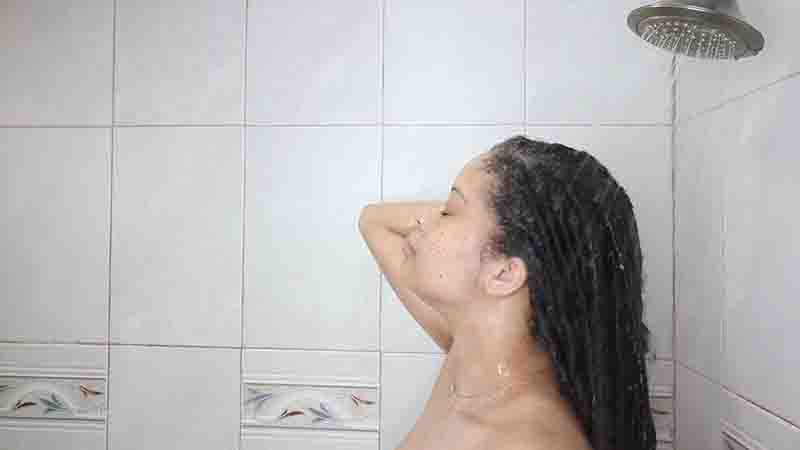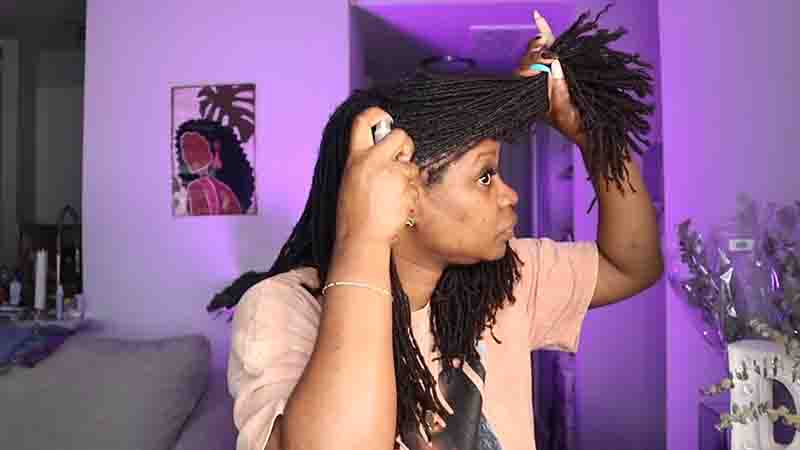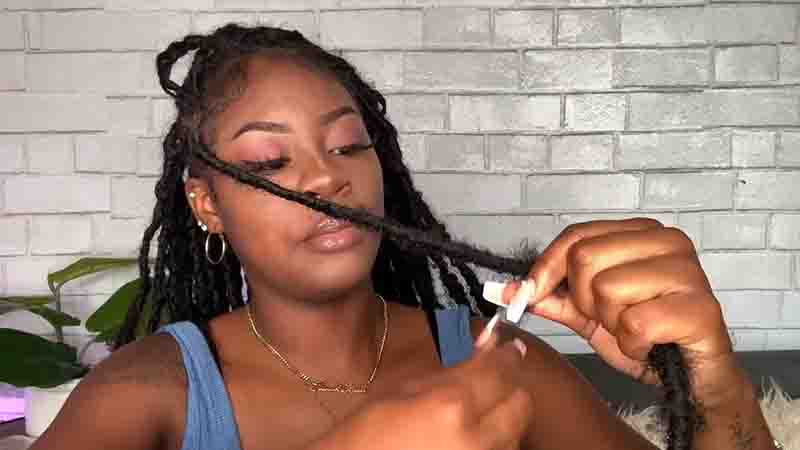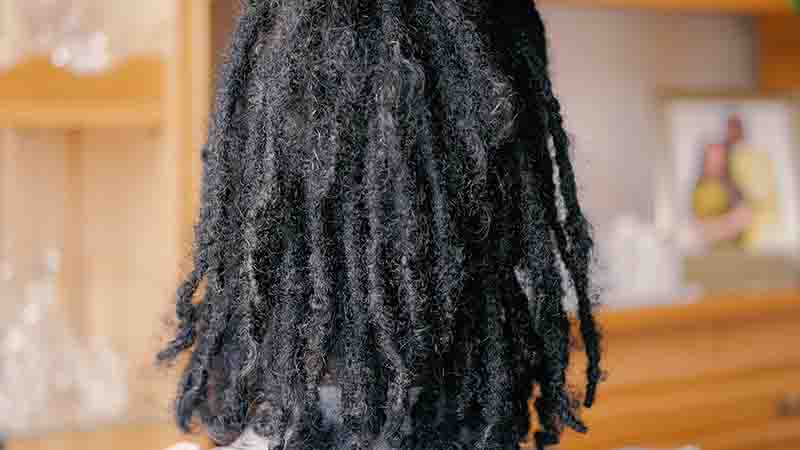Soft locs typically last for about 4 to 6 weeks before they need to be retouched or redone. Soft locs are a popular hairstyle among those with natural hair who want the look of dreadlocks without the commitment or damage that comes with traditional locs.
This style uses a method of twisting the hair using a gentle technique, creating soft, lightweight locs that can be easily maintained and styled. Soft locs provide versatility and freedom to experiment with different looks and textures, while still having the option to remove and change the style if desired.
The duration of soft locs largely depends on how well they are maintained and the individual’s hair growth rate. By following proper upkeep, soft locs can be enjoyed for several weeks at a time.
Maintenance Practices
Regular washing is an important part of maintaining soft locs. It helps to keep the scalp clean and prevents buildup of dirt and product residue. When washing your hair, use a gentle shampoo specifically designed for locs, and apply it to the roots and scalp. Massage the shampoo in circular motions to ensure thorough cleansing.

Moisturizing is crucial to keep soft locs healthy and prevent dryness. Use a water-based moisturizer to hydrate both the locs and the scalp. Apply the moisturizer from the roots to the ends, ensuring that each loc is properly moisturized. It’s important to choose products that are lightweight and won’t cause buildup.
Retwisting helps to maintain the shape and structure of soft locs. This process involves twisting the new growth at the roots, securing it in place. It’s recommended to retwist soft locs every 4-6 weeks, or whenever the new growth becomes too noticeable. Use a loc gel or cream to provide hold and keep the retwisted locs in place.
Hair Type And Texture

Hair type and texture play a key role in determining the longevity of soft locs. Different hair types have varying characteristics that can influence how long the locs will last.
| Hair Type | Texture | Loc Longevity |
|---|---|---|
| Straight hair | Fine and silky | Soft locs may unravel sooner due to the lack of natural texture. |
| Wavy hair | Moderate thickness and some natural texture | Soft locs can typically last longer than straight hair, but may require more maintenance. |
| Curly hair | Thicker and coarser texture | Soft locs tend to hold better and can last longer due to the natural texture and increased resistance to unraveling. |
| Kinky hair | Tightly coiled and highly textured | Soft locs can have the longest lifespan with proper care and maintenance due to the natural texture and strong resistance to unraveling. |
In conclusion, the hair type and texture have a significant impact on how long soft locs will last. The natural texture and thickness of the hair can affect the longevity and durability of soft locs. It is important to consider your hair type and texture when deciding on soft locs to ensure they align with your desired longevity and maintenance requirements.
Styling Choices

Soft locs are a popular choice for those seeking a low-maintenance and versatile hairstyle. The length of time soft locs last depends on various factors, including the styling choices made by the individual.
When it comes to protective styles, soft locs are an excellent option. These styles help protect the hair from daily manipulation and environmental damage.
Additionally, minimizing manipulation is crucial for extending the lifespan of soft locs. Regular styling, such as re-twisting or re-braiding, can lead to frizz and breakage. It’s important to be mindful of the frequency and intensity of manipulation to maintain the longevity of soft locs.
In terms of how long soft locs can last between styles, it varies from person to person. Some individuals may prefer to style their soft locs every four to six weeks, while others may stretch it to eight weeks or more. Listening to your hair’s needs and consulting with a professional stylist can help determine the ideal timeframe for your specific hair type and lifestyle.
Loose Or Unraveling Locs
Soft locs typically last for several weeks to a few months, depending on how well they are maintained and the specific hair texture. One common issue with soft locs is when they become loose or start unraveling. This can happen due to various reasons, such as:
- Tightening too tightly during the initial installation
- Frequent manipulation or styling
- Use of heavy products or residue accumulation
When you notice your soft locs becoming loose or unraveling, it is essential to assess the situation. If only a few locs are affected, you may choose to retwist or repair them individually. However, if a significant number of locs are loose, it might be necessary to retwist or replace all the locs to maintain a cohesive and neat appearance.
Regular maintenance, such as retwisting, is recommended every 4-6 weeks to keep your locs secure and well-maintained. Remember to consult with a professional loctician for advice tailored to your specific hair needs.

Excessive Frizz Or Breakage
Soft locs can be a stylish and versatile hairstyle, but they require diligent care to avoid excessive frizz and breakage. Several factors can contribute to these issues, including improper maintenance, product choice, environmental conditions, and styling habits. To maintain the health and longevity of your soft locs, it’s crucial to address these factors effectively.
1. Improper Maintenance
Regular Maintenance: Soft locs, like other loc styles, require consistent maintenance. Neglecting routine care can lead to frizz and breakage. Regularly retwisting and tidying up loose hairs can help maintain the neat appearance of your soft locs.
Avoid Overwashing: Overwashing can strip your soft locs of their natural oils, leading to dryness and frizz. Aim for a balance in washing frequency to keep your locs clean without overdoing it.
2. Product Choice

Avoid Heavy Products: Using products that are too heavy or contain excessive oils can weigh down your soft locs and lead to buildup. Choose lightweight, water-based moisturizers and leave-in conditioners to maintain moisture without causing greasiness.
Sulfate-Free Shampoo: Use sulfate-free shampoos to prevent harsh chemicals from drying out and weakening your locs.
3. Environmental Factors
Sun Exposure: Prolonged exposure to the sun’s UV rays can cause locs to become dry and brittle. Protect your soft locs by wearing a hat or headscarf when spending time in the sun.
Wind and Humidity: Wind can lead to tangling, while humidity can cause frizz in soft locs. To combat these factors, consider protective styles like buns or wraps and use anti-frizz products when necessary.
4. Excessive Manipulation and Styling
Minimize Excessive Styling: Frequent styling, tight ponytails, or heavy accessories can strain soft locs and lead to breakage. Be gentle with your locs and opt for protective styles that minimize manipulation.
Heat Styling: Excessive use of heat styling tools can weaken the locs. If you need to use heat, apply a heat protectant and keep the temperature moderate.
Addressing Frizz and Breakage Concerns
To address frizz and breakage in soft locs effectively, consider the following steps:
Proper Maintenance Routine: Stick to a regular maintenance routine, including retwisting as needed, gentle cleansing, and tidying up loose hairs.

Use Lightweight Products: Choose lightweight, nourishing products that provide moisture without weighing down your locs.
Protective Styling: Consider protective styles that shield your locs from environmental factors and minimize manipulation.
Environmental Protection: Protect your locs from harsh weather conditions, such as sun, wind, and humidity, with appropriate accessories and products.
Minimize Styling: Limit the use of styling tools and tight hairstyles that can weaken soft locs.
Thinning Or Weak Locs

Thinning or weak soft locs can be a frustrating issue for those who love this hairstyle. There are several potential causes for this problem, but fortunately, there are also effective treatment options available. Let’s explore the causes and solutions for thinning or weak soft locs:
Common Causes
Improper Maintenance
- Overwashing: Frequent washing or using harsh shampoos can strip away natural oils from the scalp and locs, leading to dryness and weakening of the hair shaft.
- Product Buildup: Using too many heavy or residue-producing products can accumulate in the locs, making them heavy and weak.
Excessive Manipulation
Tight Styling: Pulling, twisting, or styling the locs too tightly can put excessive stress on the hair shaft, leading to thinning and breakage.
Treatment Options
To address thinning or weak soft locs, consider the following treatment options:
- Gentle Cleansing:
- Use a residue-free or sulfate-free shampoo to cleanse your scalp and locs gently. This helps remove product buildup without stripping the locs of their natural oils.
- Moisturize with Natural Oils:
- Apply natural oils like coconut oil, argan oil, or jojoba oil to your locs to restore moisture and strengthen the hair shaft. These oils can penetrate the locs, providing essential nourishment.
- Avoid Excessive Manipulation:
- Minimize excessive pulling, twisting, or tight styling. Be gentle when retwisting or styling your locs to prevent further weakening.
- Protective Styles:
- Opt for protective styles that reduce the need for constant manipulation. These styles help protect the locs from external stressors and promote healthier growth.
- Regular Trims:
- Trim your soft locs periodically to remove split ends and prevent further damage. This can promote healthier, stronger locs over time.
- Balanced Diet and Hydration:
- A balanced diet rich in essential nutrients and proper hydration can contribute to the overall health of your hair, including your locs.
Protective Styling Advice
Protective styling is a crucial element in maintaining the health and vitality of soft locs. When selecting a protective style, it’s essential to consider how it impacts the overall well-being of your locs. Opting for styles that minimize tension and encourage hair growth is key. Styles like braids, twists, and updos can effectively protect your soft locs.
Here are some best practices to keep in mind when it comes to protective styling for soft locs:
1. Choose Low-Tension Styles
Opt for styles that do not place excessive tension on your locs. Tight hairstyles can lead to breakage and weaken your locs over time.

2. Regular Moisturization
Maintain the moisture balance of your soft locs by regularly hydrating them. You can achieve this by using a hydrating spray or applying natural oils, such as coconut oil or argan oil, to your locs. This prevents them from becoming dry and brittle.
3. Minimize Manipulation
Avoid excessive styling, twisting, or touching of your locs. Over-manipulation can lead to damage and weaken the locs. Handle your locs gently to promote their health.
4. Allow Your Locs to Breathe
Although protective styles are essential, it’s crucial to give your locs periodic breaks. Wearing protective styles continuously for extended periods can lead to product buildup and potential damage. Aim to let your locs “breathe” every few weeks to maintain their health.
5. Regular Scalp Cleansing
Maintain a clean and healthy scalp by regularly cleansing it. Use a residue-free or sulfate-free shampoo to remove any product residue and promote healthy hair growth. A clean scalp is essential for the overall well-being of your locs.
6. Variety in Protective Styles
Rotate between different protective styles to prevent repetitive stress on the same areas of your locs. This variety reduces the risk of tension and damage in specific spots.
7. Gentle Handling
Be gentle when taking down or redoing protective styles. Rushing through this process can result in hair breakage and unnecessary stress on your locs.
FAQ
Whether soft locs are worth it depends on your personal preferences and the style you desire. Soft locs can be a stylish and protective option, offering versatility without the commitment of traditional locs. They can be a valuable choice if you want to experiment with the loc look.
To prevent soft locs from frizzing, you can:
Use loc-friendly products and gel to smooth the hair.
Avoid excessive manipulation and touching.
Keep your scalp and locs moisturized.
Protect them while sleeping with a satin scarf or bonnet.
To make your locs soft, you can:
Use a moisturizing spray or oil on your locs.
Gently palm-roll or twist the locs to soften them.
Keep your locs clean and well-hydrated.
Frizz on locs may lessen over time as the hair matures and the locs tighten. However, some level of frizz can be a natural part of the loc journey, especially during the early stages of development.
The time it takes for soft hair to lock and form into locs can vary depending on factors like hair texture and maintenance practices. It may take several months to years for locs to fully mature.
Yes, your hair can grow with soft locs. While locs themselves do not inhibit hair growth, it’s important to maintain a healthy scalp and practice good hair care to support hair growth while wearing locs.
Itching with soft locs can occur due to a variety of factors, including dry scalp, product buildup, or sensitivity to certain products. Maintaining proper scalp hygiene and using moisturizing products can help alleviate itching.
The cons of soft locs may include:
Initial frizziness during the loc maturation process.
Maintenance required to keep locs neat.
Potential itching and scalp issues.
The need to be cautious of loc tension and avoid styles that may pull on the scalp.
Soft faux locs can get wet, but it’s important to dry them thoroughly afterward to prevent issues like mold, odor, and potential weakening of the extensions.
Soft locs can be a protective style that is suitable for natural hair. They help preserve the health of your natural hair by reducing manipulation and exposure to environmental factors.
Soft locs themselves should not cause breakage if they are installed and maintained properly. However, neglect, excessive tension, or tight installations can lead to breakage.
Sleeping with wet locs can promote mold growth and an unpleasant odor. It’s recommended to dry your locs thoroughly before going to bed to maintain scalp and loc hygiene.
To keep soft locs moisturized, you can:
Use a water-based moisturizing spray or oil.
Apply a leave-in conditioner to your locs.
Avoid products that may cause buildup.
Yes, you can allow your locs to air dry. In fact, air drying is often the preferred method to avoid heat damage. Ensure they are thoroughly dry to prevent issues like mold.
Locs can be a suitable hairstyle for working out, as they keep hair securely in place. However, you may want to pull them back to prevent excessive sweating on your scalp, which could lead to odor or itching.
Conclusion
To sum up, the longevity of soft locs largely depends on various factors such as maintenance, lifestyle, and hair care routine. With proper care and regular retouching, soft locs can stay intact for several months or even years. Remember to protect them from excessive manipulation and moisture to extend their lifespan.
Consult with your stylist for personalized tips and products that cater to your unique hair needs. Cheers to rocking stylish and durable soft locs for as long as you desire!

